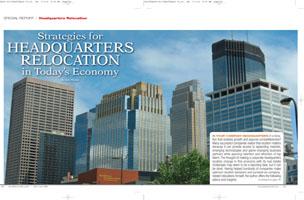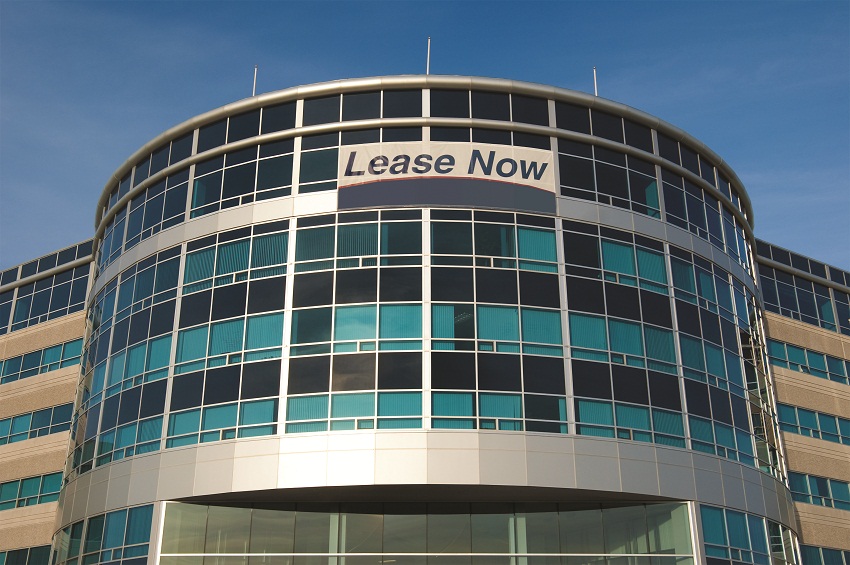
 Is your company headquarters in a location that enables growth and assures competitiveness? Many successful companies realize that location matters because it can provide access to expanding markets, emerging technologies and game-changing business partners while assuring retention and attraction of top talent. The thought of making a corporate headquarters location change in this economy with its real estate challenges may seem to be a daunting task, but it can be done. Having helped hundreds of companies make optimum location decisions and survived six company-related relocations himself, the author offers the following advice and insights.
Is your company headquarters in a location that enables growth and assures competitiveness? Many successful companies realize that location matters because it can provide access to expanding markets, emerging technologies and game-changing business partners while assuring retention and attraction of top talent. The thought of making a corporate headquarters location change in this economy with its real estate challenges may seem to be a daunting task, but it can be done. Having helped hundreds of companies make optimum location decisions and survived six company-related relocations himself, the author offers the following advice and insights.
Selecting a Headquarters Location
Before the company seeks a destination, consider the following questions:
1. What strategic issues and opportunities need to be addressed in order to assure the growth and competitiveness of the company?
2. Can we continue to be successful where we are or should we consider other locations?
3. What opportunities, risks and costs can be derived from changing the headquarters location?
4. What approach should be utilized to effectively identify the best location for the company’s headquarters?
Based on experience, there is a six-step process that is effective in selecting an optimum location and implementing a relocation. Initially, the business case for the company is reviewed along with the strategies that will make it a success over the next five to 10 years. In addition, the challenges it faces in the current location are reviewed along with the potential opportunities in a new destination. Frequently, company leadership has a general idea of possible destinations to consider.
 First advice: check the price tag before buying. Before ambling into selecting a new location, it is recommended that an objective feasibility analysis be conducted that identifies opportunities versus risks and related costs utilizing a proxy city. This allows the executive team to quickly hone in on the potential upside as well as issues that might arise from relocation and determine whether it’s reasonable to proceed. It may sound like a party-crasher, but this effort provides a needed reality check before too much momentum is gathered toward relocation.
First advice: check the price tag before buying. Before ambling into selecting a new location, it is recommended that an objective feasibility analysis be conducted that identifies opportunities versus risks and related costs utilizing a proxy city. This allows the executive team to quickly hone in on the potential upside as well as issues that might arise from relocation and determine whether it’s reasonable to proceed. It may sound like a party-crasher, but this effort provides a needed reality check before too much momentum is gathered toward relocation.
Second advice: utilize a well-structured selection process that reaches a logical conclusion. Once the feasibility analysis has proven to have a positive outcome, the team can embark on selecting potential cities for consideration. Companies that engage in a thoughtful and effective selection process have proven to make better decisions in a shorter time. The process begins with gathering a list of specific locations identified by the company’s project team that may meet the needs of the organization along with criteria that can be utilized to compare with and screen other locations. There are a variety of criteria utilized such as geographic location, proximity and access to certain markets or company facilities, reasonable operating costs, favorable regulations and tax rates, availability of certain talent, specific industry presence, quality of life factors, and others. All this input is prioritized and incorporated into a series of evaluation steps that result in a short list of location candidates to be considered by the organization.
 Third advice: test drive and kick the tires. Gain an up-close view of each top location candidate to evaluate its potential to meet specific strategic objectives. The trip is not only for fact finding, but also to gain intangible feedback of whether the location has the culture and image for the organization—what are the first impressions. A selected group of local employers may be interviewed to share insights into the local business climate as well as review options for office and residential real estate. The coordination of the trip and feedback received will form very critical perceptions of the community for the company. If you want to keep this trip confidential, you need to take specific steps to maintain anonymity.
Third advice: test drive and kick the tires. Gain an up-close view of each top location candidate to evaluate its potential to meet specific strategic objectives. The trip is not only for fact finding, but also to gain intangible feedback of whether the location has the culture and image for the organization—what are the first impressions. A selected group of local employers may be interviewed to share insights into the local business climate as well as review options for office and residential real estate. The coordination of the trip and feedback received will form very critical perceptions of the community for the company. If you want to keep this trip confidential, you need to take specific steps to maintain anonymity.
Fourth advice: ultimate success is based on wise negotiations and effective internal marketing. Once the top city candidate list has been refined to a select few, and relocation is a viable option, it is time to negotiate. On the subject of incentives, don’t view it strictly as a discussion about cash. In reality, an incentive is any opportunity or resource that provides an advantage for the company and offsets the up-front cost of relocation. This may be cash, a reduction in taxes, lower rent for a period of time, reduction in the cost of services or temporary lodging, and many other options. Be creative, but also remember that in the end the individuals you negotiate with may ultimately be your neighbors and potential local business associates.
 As the discussions with communities are concluded, the feasibility evaluation and location selection results are packaged into a report and PowerPoint presentation. It is time to present to and seek approval from the senior executive committee and/or board of directors. Unless a company is considering relocation to a destination of lower cost, or is making significant reductions in staff, the financial rationale must come from any strategic advantages that may be anticipated. Putting an exact value on these advantages may be a challenge but certainly a critical basis for the relocation. Presenting the case and achieving an affirmative vote will require some effective marketing that states the facts, defines the vision and builds the case. From experience, the presentation needs to be well crafted and articulately presented, particularly in these economic times with the increased sensitively on leadership accountability. The board typically pursues questions that focus on the following issues:
As the discussions with communities are concluded, the feasibility evaluation and location selection results are packaged into a report and PowerPoint presentation. It is time to present to and seek approval from the senior executive committee and/or board of directors. Unless a company is considering relocation to a destination of lower cost, or is making significant reductions in staff, the financial rationale must come from any strategic advantages that may be anticipated. Putting an exact value on these advantages may be a challenge but certainly a critical basis for the relocation. Presenting the case and achieving an affirmative vote will require some effective marketing that states the facts, defines the vision and builds the case. From experience, the presentation needs to be well crafted and articulately presented, particularly in these economic times with the increased sensitively on leadership accountability. The board typically pursues questions that focus on the following issues:
• Potential loss of key leadership talent and intellectual assets.
• Ability to hire critical replacement staff in the destination location.
• Disruption to the overall organization that may impact revenues and profit margins.
• The ultimate cost will be significantly more than anticipated, particularly with the uncertainties of the real estate market.
• The location will not prove to deliver the attributes and performance as projected.
 Implementing a Relocation Event
Implementing a Relocation Event
Fifth Advice: this is where the “fun” begins. You may have done an excellent job of selecting a location, negotiating great incentives and gaining the approval of the board, but now you face the relocation of families that may have teenagers in high school, elder family members being cared for, spouses with a terrific jobs that will be hard to replace, and homes that are financially “under water.” There are annual surveys conducted by the relocation industry that identify the top reasons employees resist a relocation. The current top reasons are (1) the ability to sell the house or the house has sustained substantial loss in value; (2) family-related issues and local ties; and (3) spousal employment and the ability to replace the job in the destination location. In addition, the company may also have a building to sell in a soft market or a lease that will be costly to break. It should be noted that the commercial and residential real estate situation is beginning to improve in selected markets and local situations in the current and destination markets need to be considered in the overall decision process. Having been involved with preparing many companies and organizations for relocation, embarking on this effort can have a successful outcome, but it takes careful thought, a relocation policy that fairly addresses the issues and some creative alternatives to selling commercial real estate.
Sixth advice: communicate, communicate and communicate . . . and timing is everything. Assuming the process has been “under wraps” up to this point, it is vitally important to chart out the course of milestone events and work through the details before going public with an announcement. A relocation policy needs to be drafted and approved, the overall time schedule for implementing the relocation roughed out and a series of anticipated questions identified and addressed. Communiqués for both employees and the general public need to be prepared and scheduled along with selecting the appropriate location and type(s) of media utilized (news conference, company meeting, email, website, etc.). Make sure that the employees hear the announcement just prior to it going public or there will be very hard feelings. Provide a place for employees to get additional policy information immediately after the announcement that may include hard copy and/or a special location on the company website.
 Relocation-Related Policies
Relocation-Related Policies
Seventh advice: relocation-related policies need to be reasonable and equitable. Dealing with the details of relocation-related policies is beyond the scope of this article, but we can address the basics. In one respect a relocation policy is an incentive package—similar to what a city offers a company to select a specific destination. An over-riding objective of a policy is to incent employees who are needed to make the relocation to accept the opportunity. The policy must be well defined and fair, but can have different tiers for different levels within an organization. Although everyone may not be invited to make the relocation, those relocating and those not relocating must be given equal treatment within each level of the organization.
Costs that are typically incurred in a major relocation include relocation of employees, severance and short-term retention of non-relocating employees, employee replacement in the destination location, company-related real estate including relocation of office contents, and other related expense. In the current economic and housing situation, there may also be a significant loss in home value in specific locations that will mean a substantial reduction in equity to purchase a home in the destination location.
Relocation policies can be structured in different ways ranging from lump-sum payouts to direct reimbursement for specified expenses. Both approaches have their merit and will prove effective in certain circumstances and there are certain types of incentives that can be utilized. A relocation policy consultant can advise on the best approach.

Liquidating and Acquiring Headquarters Property
Eighth advice: do your homework early on commercial real estate markets. Knowing the market situation in the current and potential destination locations is important input for the initial feasibility analysis and in making cash flow projections for the relocation event. Having to either sell property or break a lease in the current location and being open to either leasing or purchasing property in the destination location will have different impacts on cash flow. For example, if the company owns its existing property and can sell it in a reasonable time period, and then consider leasing property with an option to buy in the destination location, part of the income gained from the sale might be utilized to fund a portion of the relocation.
Even if the economy and real estate markets are less than ideal, companies need to position themselves to thrive and move forward. If a company’s strategy requires relocating the headquarters or other operation, it can be accomplished cost-effectively if the effort is thought through carefully and an element of creativity is incorporated into the process.

